Essays
The potter's wheel is ancient, but potters were making pots for thousands of years before the invention of that useful and speedy tool. The same is true of glazes, those layers of molten material fired onto the surface of the clay which forms the body of a pot. Pottery does not have to be glazed, and it does not have to be thrown on a wheel.
Jennifer Lee is a young British potter who uses neither wheel nor glazes. It should hardly be surprising, therefore, that one of the bases of her work is an interest in artifacts from early and ancient civilizations - Minoan, Mycenean, and Pre-Columbian pots for example. At the same time, Lee's work shows she is perfectly aware of the 20th-century tradition, to which she is making a notable addition. Her pots combine a kind of timeless archaism with a refined modernity.
At a period when stylistic pluralism is rampant and all sorts of elaborate, mannerist, funky, or eccentric ceramic objects - often overdecorative or excessively colored - are presented under the banner of “studio pottery,” the serene presence of Lee's pots stands out in strong contrast. This should not suggest they are somehow stark; they have a contained warmth. But they are restrained. They are certainly neither pretentious nor self-conscious. They seem to deal with essentials. They dare to seem quite simple - vessels springing up with scrupulous, taut profiles from very small, even hidden, bases. They are sometimes bowls wide open to the air, sometimes taller containers with gourd-like bellies, whose elliptical contours change angle higher up their form, like a subtly articulated joint.
She names “influences,” calling them “accumulative rather than direct” filtering through” her work. The sense of balance that Lee's vessels possess is visual as well as gravitational. (She is not at all a potter who plays psychological games with unnerving imbalances.) Still, their vitality comes partly from that slight tilt or scarcely perceptible shift off-center which make all the difference between a pot mathematically measured and a pot exhaustively judged by the eye, hand, and thought of the potter. Asymmetry is never banal or obvious in Lee's pots; it is part of their naturalness and their humanity, never explored just for effect.
The line between “craft” and “art” has now become marvellously unclear. Work like Jennifer Lee's (not that there is much work around of such quality) is displayed in galleries with no less respect than sculpture or paintings, and it is as an artist that she talks and writes about her work. She names “influences,” calling them “accumulative rather than direct ” filtering through” her work. And such sources of inspiration are in the area of attitudes and ideas rather than style. She cites the work of Joseph Beuys, of Antoni Tapies, and of Walter de Maria - all “artists” rather than “crafts persons,” but all concerned with “non-art” materials.
“It is a mistake to talk of the artist looking for his subject. In fact the subject grows within him like a fruit and begins to demand expression.” Andre TarkovskyTapies' fascination for the crumbling disrupted surfaces of graffiti-defaced walls, and his use of commonplace and discarded substances for his art, may not immediately strike the viewer as likely to appeal to Lee's fine sensibility. Her pots are images of vital structure rather than ruin, evidence of formation, not deformation. Furthermore, she quotes Andrei Tarkovsky (a potter inspired by a filmmaker): “It is a mistake to talk of the artist looking for his subject. In fact the subject grows within him like a fruit and begins to demand expression” - a positive, subjective, natural development. And yet - one of the somewhat paradoxical tensions that I suspect go to make Lee's work so subtly authentic - she lists categorically among her “interests and concerns”: “decay, corrosion, erosion - be it rusting metals, lichen, aging of wood/rock etc., decrepit walls. The visible evidence of decay around us. Rather in the pots - encapsulating a moment of decay.”
If the form aspect of her pots contradicts such interests, the texture and color do not. And yet it is not really possible, except in theory, to separate one from the other because the colors, like rock strata or auras, are actually in the clay itself, part of the very construction of her pots. In this respect she has developed an idea British potter Lucie Rie discovered for her own work in the late 1960s: using different colored clays in the body of a pot. But Rie uses the wheel, and the result is that the different colors spiral. She also glazes her pots, so the inherent colors show through only to the extent the glazed surface allows.
Lee's colors are part of the coiled and pinched construction of her hand-built pots, and so they often lie or float horizontally. She uses no glaze, so these seams of color are both surface and body. Still bare to the eye, they link the inner and outer surfaces of the pot's walls. In this way she goes back to the primitive, pre-glaze origin of color in pots.
She has explained: “I colour my pots by the addition of oxides, body stains, and underglazes to the clay slip rather than by application of color to the surface.... This gives an even color through the pot and a complete fusion of the clay body and stain. I am specifically interested in the migration of oxides and the interaction of color.” Perhaps it is incidental, but when she trained at Edinburgh College of Art, Lee did tapestry as well as ceramics. Perhaps from working with cloth she found a parallel between warps and wefts and interwoven colors, and coiled potmaking.
Saba, as an element of beauty, embodies the link between art and nature. In a sense the Japanese could be said to be trying to master time aesthetically.In Tarkovsky's book "Sculpting in Time", the filmmaker discusses a Japanese concept called saba. This notion might cast some light on Lee's appreciation of corrosion and decrepitude. Tarkovsky quotes from an account of Japan by the journalist Ovchinnikov: “It is considered that time, per se, helps to make known the essence of things. The Japanese therefore see a particular charm in the evidence of old age. They are attracted to the darkened tone of an old tree, the ruggedness of a stone, or even the scruffy look of a picture whose edges have been handled by a great many people. To all these signs of age they give the name, saba, which literally means 'rust.' Saba, then, is a natural rustiness.... Saba, as an element of beauty, embodies the link between art and nature. In a sense the Japanese could be said to be trying to master time aesthetically.”
Trying to “master time aesthetically” is also central to pottery - to using minerals in their plastic state that have been softened over eons into clay by geological change, capturing this fluent stone without losing its essential character, and then hardening and rigidifying it back into stone by firing. In the image remains something of the process of making its hard, brittle finality still bear the marks of its softness and mobility.
Conversely, the survival of ancient pottery is, in itself, a remarkable part of its character for us. In pottery, there is some sort of conviction of the lasting and enduring as well as of age and change. A potter of Jennifer Lee's capability and sensitivity recognizes that her art cannot escape its place in the age-old context of pottery as one of the most direct form-making activities of mankind.
If Lee's collectors (and they are certainly eager for her pots) relish the calm elegance and control of her work, and treat it like precious “high art,” one hopes they also feel and see the abraded, gritty substance and sometimes unexpectedly intense tonal contrasts which give these pots a toughness to counter mere surface. They are like superbly peeled apples, as if the shiny skin has been pared away to disclose the rougher - and also more vulnerable - flesh. Or like stones eroded over millennia, reduced to their essence.
Christopher Andreae
April 8, 1991 © The Christian Science Monitor.
Published to coincide with Jennifer Lee's first solo show in New York at the Graham Gallery.


24 x 30 cm
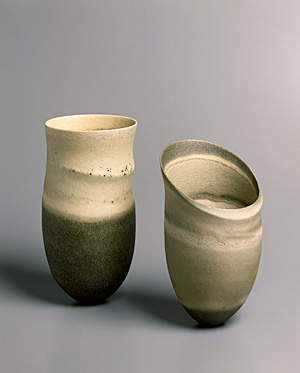
R- Tilted rim, ridge 1989
L 24 x 12 cm. R 22 x 11 cm.
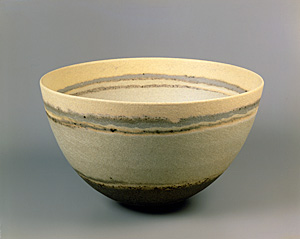
20 x 35 cm.
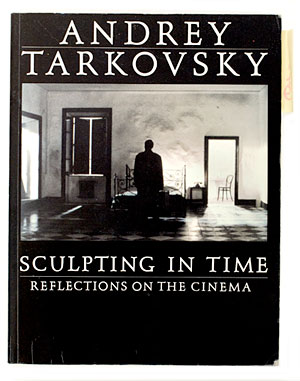
The Bodley Head, London, 1986.
Cover image from the film Nostalgia

Long-term installation at 141 Wooster Street, New York City. Photo: John Cliett. Copyright Dia Art Foundation.
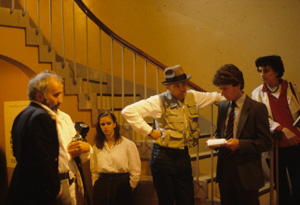
1981 Photo: Jennifer Lee
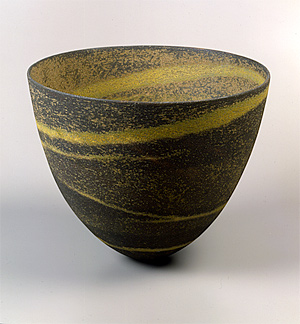
24 x 30 cm.